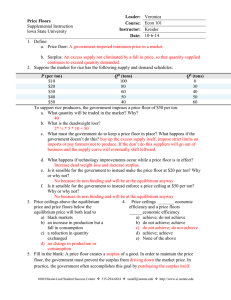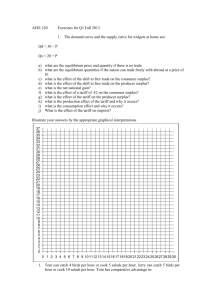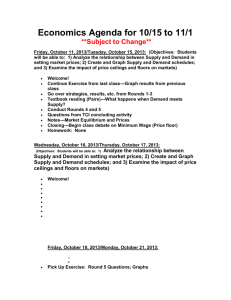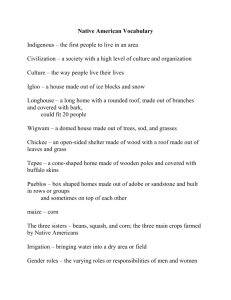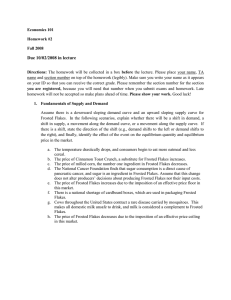Price Ceilings and Price Floors
advertisement
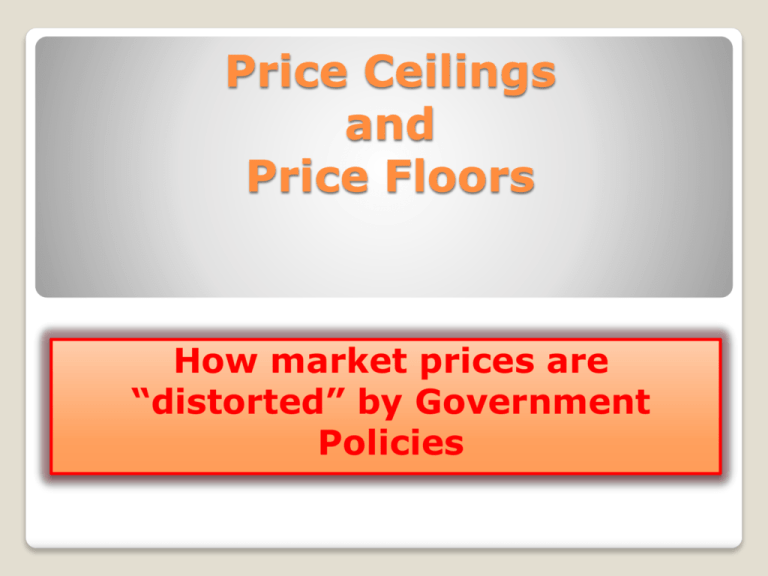
Price Ceilings and Price Floors How market prices are “distorted” by Government Policies SUPPLY/DEMAND AND GOVERNMENT POLICIES---PRICE CEILINGS AND PRICE FLOORS In a free, unregulated market system, market forces establish equilibrium prices and quantities. While equilibrium conditions may be efficient, not everyone will be satisfied with prevailing market price (either too high or too low) Price controls are usually implemented when it is perceived that the market price is unfair to either buyers OR sellers SUPPLY/DEMAND AND GOVERNMENT POLICIES---PRICE CEILINGS AND PRICE FLOORS Price Ceiling A legal maximum on the price at which a good can be sold. Price Floor A legal minimum on the price at which a good can be sold. We are going to examine a PRICE FLOOR… There are two prominent “real world” examples of Price Floors. One is the “Minimum Wage” law and the other is the pricing-setting by government of various agricultural commodities. I am going to use the Example of Price Floors established by the Government in the Agricultural Market(s) SUPPLY/DEMAND AND GOVERNMENT POLICIES--PRICE CEILINGS AND PRICE FLOORS Two outcomes are possible when the government imposes a price floor: The price floor is not binding if set below the equilibrium price. The price floor is binding if set above the equilibrium price, leading to a shortage We will look at a BINDING Price Floor and a NON-Binding Price Floor Market for _________________ Price Of ___ S* “A” Pe Lets assume this market represents the “Free” Market for Corn in the US and it is in “normal” equilbrium at: “Pe” and “Qe”---Point “A” D* Qe Quantity of _____________ Market for _________________ Price Of ___ S* “A” Pe Assume the growers of Corn Experience a bumper crop and They harvest significantly more Than they expected. In the Market For Corn the SUPPLY of Corn is Going to INCREASE. The SUPPLY Curve will Shift to D* the RIGHT. (next slide) Qe Quantity of _____________ Market for _________________ Price Of ___ S* S “A” 1 The Market Price For Corn DECREASES From “Pe” to “P1”. Pe “B” P1 D* Qe Q1 This is NOT good for farmers to receive a Lower price than before. It might cause financial Hardships and some farmers Might go out of business. “SAVE THE “FAMILY” FARM!” Quantity of _____________ Was the cry from the Heartland! Market for _________________ Price Of ___ S* “A” Pe “B” P1 D* Qe Q1 Quantity of _____________ S1 The Farm Lobby can lobby Their favorite Congressperson/Senator and encourage the imposition of a PRICE FLOOR. A PRICE FLOOR establishes a MINIMUM price that the good can be sold for. It CANNOT be sold for LESS! Market for _________________ Price Of ___ S* S1 Assume the Government sets the Price Floor at the previous equilibrium price Of “Pe”. (next slide) “A” Pe “B” P1 D* Qe Q1 Quantity of _____________ Market for _________________ Price Of ___ S* S “A” “C” Pe = Price Floor “B” P1 D* Qd Q1 Qs Quantity of _____________ 1 If the Market Price is truly at Point “B” and the government sets the price at “Pe”, then the Quantity Demanded at “Pe” is at Point “A” (Demand Curve did not shift) but the Quantity Supplied is at Point “C” (Supply curve shifted to the RIGHT). Quantity Supplied is greater than Quantity Demanded. There will be a SURPLUS in the market for Corn (Seen on next slide) Market for _________________ Price Of ___ S* “A” “SURPLUS”“C” Qs - Qd Pe = Price Floor “B” P1 D* Qd Q1 Qs Quantity of _____________ S 1 The market wants to buy and sell at Point “B” but the Price Floor prevents it. The Price Floor stays in place as long as the Market price stays BELOW the Price Floor of “Pe”. This Price Floor is said to be BINDING Farmers get paid an higher price and the government takes possession of the surplus and uses it as (1) foreign food aid (2) Federal School lunch programs. However, the main result is consumers of Corn pay a higher price than they otherwise would absent the PRICE FLOOR. Market for _________________ Price Of ___ S* “A” “SURPLUS”“C” Qs - Qd Pe = Price Floor “B” P1 D* Qd Q1 Qs Quantity of _____________ S 1 Now assume in the following growing season the crop is a disaster and the harvest is poor. The Supply of Corn is going to DECREASE at every price, hence the Supply Curve will shift to the LEFT. This gets messy on the next slide. I will clean it up on a subsequent slide. Market for _________________ S Price Of ___ 2 S* “D” P2 “A” “SURPLUS”“C” Qs - Qd Pe = Price Floor “B” P1 D* S 1 Told you, Messy! Notice the Supply Curve (“S1”) shifted to the LEFT (“S2”). We now have a NEW Market Quilibrium Price of “P2” and Quantity “Q2” at Point “D”. The NEW Price is ABOVE the established PRICE FLOOR. Q2 Qd Q1 Qs Quantity of _____________ Let me clean this up on the next slide. Market for _________________ S Price Of ___ 2 S* “D” P2 “A” Since the Martket Price is above the minimum Price Floor Farmer will be able to receive the Market Price “P2” and not the Price Floor “Pe” Pe = Price Floor D* Q2 Qd Quantity of _____________ The Price Floor now becomes “NON-BINDING” at Point “D” If the Market Price falls below the Price Floor then the “Pe” will become BINDING again. Fun Stuff!

